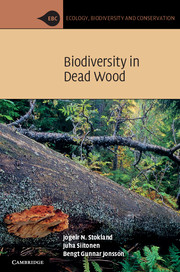Book contents
- Frontmatter
- Contents
- Preface
- 1 Introduction
- 2 Wood decomposition
- 3 The saproxylic food web
- 4 Other associations with dead woody material
- 5 Host-tree associations
- 6 Mortality factors and decay succession
- 7 Microhabitats
- 8 Tree size
- 9 The surrounding environment
- 10 Evolution of saproxylic organisms
- 11 Species diversity of saproxylic organisms
- 12 Natural forest dynamics
- 13 Dead wood and sustainable forest management
- 14 Population dynamics and evolutionary strategies
- 15 Threatened saproxylic species
- 16 Dead wood in agricultural and urban habitats
- 17 The value and future of saproxylic diversity
- References
- Index
3 - The saproxylic food web
Published online by Cambridge University Press: 05 June 2012
- Frontmatter
- Contents
- Preface
- 1 Introduction
- 2 Wood decomposition
- 3 The saproxylic food web
- 4 Other associations with dead woody material
- 5 Host-tree associations
- 6 Mortality factors and decay succession
- 7 Microhabitats
- 8 Tree size
- 9 The surrounding environment
- 10 Evolution of saproxylic organisms
- 11 Species diversity of saproxylic organisms
- 12 Natural forest dynamics
- 13 Dead wood and sustainable forest management
- 14 Population dynamics and evolutionary strategies
- 15 Threatened saproxylic species
- 16 Dead wood in agricultural and urban habitats
- 17 The value and future of saproxylic diversity
- References
- Index
Summary
Almost every ecology textbook includes a chapter or section on food chains or food webs. Such texts are normally accompanied by an example that starts with a photosynthetic primary producer (the lowest trophic level), followed by a herbivore feeding on the producer, next perhaps some medium-sized predator, and finally a conspicuous top predator (third or fourth trophic level). Subsequently, the example might be expanded with additional organisms at each trophic level to illustrate the concept of a food web. The specific example could be from the marine environment starting with photosynthetic plankton algae and ending with a seal or whale species. Alternatively, the example might depict an African grassland food web, ending up with the powerful cheetahs and lions as top predators.
It is typical that nearly all food web examples have herbivores at the second trophic level. We tend to view decomposer communities as simpler systems composed of two organism groups: decomposers, i.e. bacteria and fungi, and detritivores, i.e. animal consumers of dead matter (Begon et al., 2006). This is far from the truth for the communities associated with decaying wood, which represent complex food webs with several trophic levels above the primary producers (the trees). One can also find all kinds of species interactions, such as predator–prey, competition, parasitism and symbiosis, that are well known from other communities.
- Type
- Chapter
- Information
- Biodiversity in Dead Wood , pp. 29 - 57Publisher: Cambridge University PressPrint publication year: 2012
- 12
- Cited by



